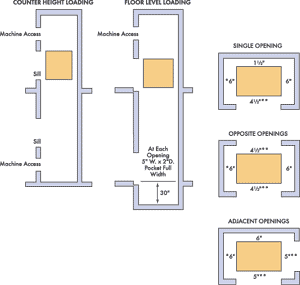Vertical Materials Handling Systems aka Dumbwaiters
Example of specifications for traction dumbwaiter
Part 1 - General 1.1
Section Includes
A. Furnish and provide all materials and labor necessary for the complete installation of one commercial traction dumbwaiter.
B. Obtain information on conditions affecting work at jobsite, including verification of dimensions, field material for anchoring, accessibility and storage space. Verify voltages and outlets on electrical drawings.
|
1.2 Work Done By Others
A. Suitable, legal, two-hour fire rated hoistway, if consistent with building construction.
B. Hoistway door walls must not be erected until doors are set in place.
C. Electrician shall furnish power supply with line disconnect switch immediately adjoining the controller cabinet.
D. Hoistway free of all pipes and obstructions.
E. All bracket fastening inserts and other steel required for support of guide rails and brackets.
F. Painting of exterior walls and prime finished components which are exposed to view, including inside of car, car gates and doors.
G. Machine area lighting and convenience outlet.
1.3 References
Design and installation shall be in compliance with regulations and all governing agencies. Lift shall be subject to local, city and state approval prior to installation, along with city and state inspection after installation. Special local requirements shall be determined and handled locally by distributor with manufacturer's agreement.
1.4 Submittals
Submit drawings or manufacturer's literature for approval. Drawings shall show rough-in requirements and wiring materials.
1.5 Substitutions
No substitutions will be considered unless written request for approval has been submitted by the bidder and was received by the architect at least ten (10) days prior to the date of receipt of bids. Each such request shall include the name o the materials for which it is to be substituted and a complete description of the proposed substitute including drawings, cuts, performance and test data, a list of projects of similar scope, photographs of existing installations and any other information necessary for evaluation.
1.6 Testing
The dumbwaiter shall be tested after installation to demonstrate:
- Accuracy of stops
- Operation of hoistway door locks and car gate switch (es).
- Operation of final terminal switches
- Operation of push-button and key switches
- Capacity load test. Operate dumbwaiter for a period of twenty (20) minutes with a capacity load. Run dumbwaiter from top terminal floor to bottom floor with one minute between starts after each stop.










